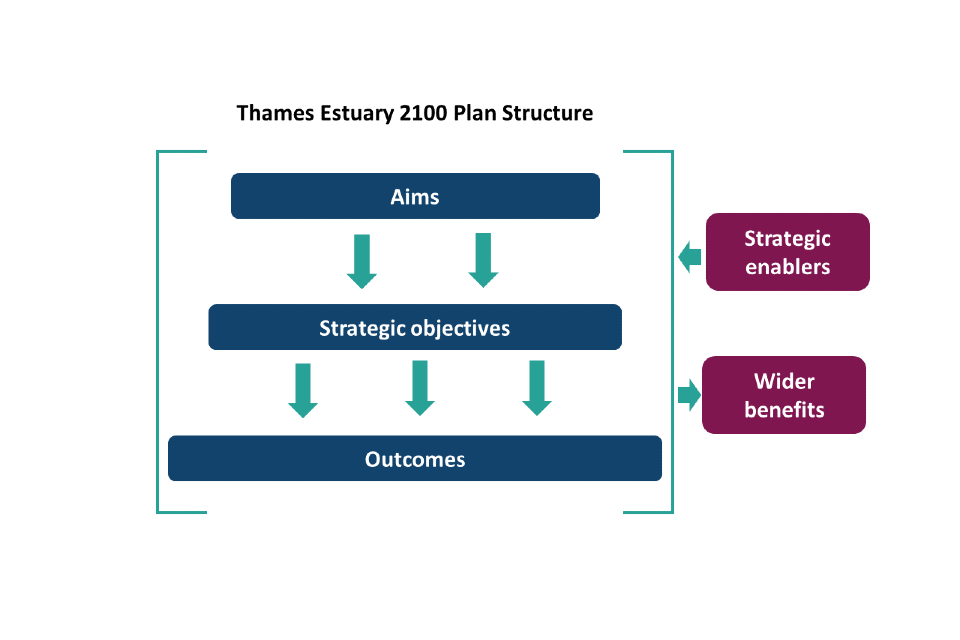Aims and objectives: Thames Estuary 2100
The Environment Agency’s aims and objectives for Thames Estuary 2100.
Applies to England
The updated Thames Estuary 2100 Plan (2023) sets out the link between our high-level aims and objectives and what we need to do to realise them. The Plan includes, in order:
- 3 high-level aims
- 9 strategic objectives and 2 strategic enablers
- 13 outcomes
We have also worked with our partners to identify the benefits our outcomes can bring.

A diagram showing the structure of Thames Estuary 2100. It shows that the Plan’s aims lead into the strategic objectives, which lead into the outcomes. The strategic enablers will help us achieve the aims, objectives and outcomes. In turn, this will produce wider benefits.
Aims
The Thames Estuary 2100 Plan (TE2100) is a strategic plan for adapting to rising sea levels in the estuary, with 3 main aims.
Aim A
Take an adaptive approach to manage tidal flooding and create climate resilient communities.
Aim B
Protect and enhance the value of the Thames, its tidal tributaries and floodplain. Deliver social, cultural and commercial benefits for communities and support resilient growth.
Aim C
Tackle the climate and nature crises by putting sustainability at the heart of this Plan. Restore ecosystems, reduce carbon emissions, and deliver environmental and biodiversity net gain.
Strategic objectives
The strategic objectives set out what needs to be done by:
- the Environment Agency
- flood risk management authorities
- planning authorities
- other organisations, businesses and communities in the estuary
There are 9 strategic objectives within the Plan:
-
Maintain flood defences in line with the flood risk management policies.
-
Adapt and improve all existing flood defences by the current deadlines set out in this Plan.
-
Accelerate preparations to decide on an end-of-century option by 2040. The preferred option and timeline may change as this Plan adapts to future changes.
-
Track indicators of change and review every 5 years. Update this Plan at least every 10 years using an adaptive FCERM (flood and coastal erosion risk management) economic approach, based on monitoring evidence.
-
Work together to develop community-led visions for future riversides. These will drive defence upgrades and identify where to deliver wider benefits.
-
Embed carbon reduction pathways within this Plan, striving to achieve carbon net zero status.
-
Replace habitat lost to sea level rise over the course of this Plan. Support nature recovery and deliver environmental net gain.
-
Improve understanding of the link between sea level rise and other sources of flood risk. Use spatial and emergency planning to create resilient communities.
-
Share experience, innovation and learning of delivering and reviewing the Thames Estuary 2100 Plan with others planning to mitigate future climate risks.
Strategic enablers
Underpinning our objectives are 2 strategic enablers. They will help us and our partners achieve the Plan’s objectives. The 2 strategic enablers are:
Strategic objective 10 (strategic enabler): develop and put in place a strategy to secure land to deliver this Plan. This will ensure future options remain viable and maximise opportunities for wider benefits.
Strategic objective 11 (strategic enabler): Develop and put in place a long-term investment strategy for this Plan. This will enable us to realise the financial benefits of an adaptation pathways approach.
How our aims link to the strategic objectives
Each of the 3 aims links to one or more strategic objective.
Aim A: Take an adaptive approach to manage the risk of tidal flooding
This aim links to:
Strategic objective 1. Maintain flood defences in line with the flood risk management policies.
Strategic objective 2. Adapt and improve all existing defences by the current deadlines set out in this Plan.
Strategic objective 3. Accelerate preparations to decide on an end-of-century option by 2040. The preferred option and timeline may change as this Plan adapts to future changes.
Strategic objective 4. Track indicators of change and review every 5 years. Update this Plan at least every 10 years using an adaptive FCERM economic approach based on monitoring evidence.
Strategic objective 5. Work together to develop community-led visions for future riversides. These will drive defence upgrades and identify where to deliver wider benefits.
Strategic objective 8. Improve understanding of the link between sea level rise and other sources of flood risk. Use spatial and emergency planning to create resilient communities.
Aim B: Protect and enhance the value of the Thames, its tidal tributaries and its floodplain
This aim links to:
Strategic objective 5. Work together to develop community-led visions for future riversides. These will drive flood defence upgrades and identify where to deliver wider benefits.
Aim C: Tackle the climate and nature crises
This aim links to:
Strategic objective 6. Embed carbon reduction pathways in this Plan, striving to achieve carbon net zero status.
Strategic objective 7. Replace habitat lost to sea level rise over the course of this Plan. Support nature recovery and deliver environmental and biodiversity net gain.
Outcomes
Our outcomes set out what the Environment Agency and our partners need to do to achieve these aims and strategic objectives.
Outcomes apply to the whole estuary, but you should interpret them based on what’s required in a specific area. For example, the height of a flood defence or a council’s Local Plan.
Find the local requirements for each policy unit using the Thames Estuary 2100 map.